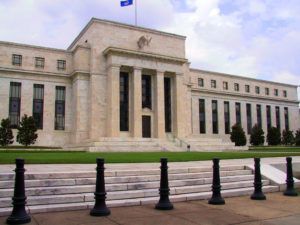
At last, a powerful critique of the economic harm caused by the Federal Reserve’s artificially low interest rate policy (brought to light by Judy Shelton in an excellent blog for The Hill). “Financial Repression: the Unintended Consequences,” published by the Swiss Reinsurance Company, is must reading for the Republican presidential campaigns.
The ”financial repression” in the title refers to “the ability of policymakers to direct funds to themselves that would otherwise go elsewhere.” The cost of the Fed’s policy of financial repression includes $470 billion in lost interest (net of lower debt costs), denied not only to household savers directly, but also to pension funds and insurers which indirectly benefit households. And interestingly, Swiss Re reckons that financial repression results as much through regulatory actions as through monetary manipulation.
The policy is also cited for having fueled a bubble in asset prices. But what is most disturbing is that financial repression “has induced a re-allocation of capital across markets and greatly enhanced the role of public markets at the detriment of private market activities. Artificially low – or in some cases even negative – interest rates break the credit intermediation channel which can crowd out viable private investors. This lowers their ability to channel funds to the real economy.”
This is the quantitative explanation for why the Wall Street Journal thinks “the Fed should wonder if its policies haven’t become an impediment to faster growth. Maybe letting markets begin to set interest rates again would lead to a better allocation of capital ….”
Academic economists have been disappointingly slow to quantify the distortions wrought on the American economy by the Fed’s sustained low interest rates. Hedge fund managers and investors have done a much better job pressing the indictment, people such as Stanley Druckenmiller (Duquesne Capital, who has partnered with Kevin Warsh at Hoover), Sam Zell (Chicago real estate magnate), Sean Fieler (Equinox Partners), and Stephen Schwarzman (co-founder of Blackstone).
This week, Schwarzman noted in his Wall Street Journal op-ed that “the number of community banks declined by 41% between 2007 and 2013,” leaving small business owners “particularly vulnerable.” He blames this, in part, on the Fed’s implementation of Dodd-Frank’s excessive regulation.
But it goes further. The Federal Reserve’s pursuit of a risk-free financial system under Dodd-Frank authority has wrought havoc on the largest big banks as well, causing them to limit lending to the federal government or sitting on their reserves on deposit at the Fed. Here’s a Cleveland Federal Reserve Bank staff report: “As a result of these new Federal Reserve policies, holding reserves is now much more attractive to banks [than making loans].”
George Gilder has an even harsher critique of the Fed’s dealings with banks in a new book released just last week: “By intimidating the financial sector with constant litigation and becoming addicted to fees and fines, government regulators have turned banks into their harem of well-fed eunuchs, periodically whipped and blandished and, finally, stultified.”
It isn’t, then, just the economic failure to launch which can be laid at the feet of the Federal Reserve. It is also the regulatory strangulation of the banking industry (of which Senator Elizabeth Warren is such an unabashed fan) and the potential for a devastating popping of the Fed’s asset bubble.
And then there’s the coming fiscal tsunami. The Federal Reserve has been telegraphing its intention to raise interest rates. Unfortunately, it has given away its tools for accomplishing this. What they have left is raising the interest rate paid to banks on their Fed deposits (that’s right, the Fed is paying banks not to use their funds productively). Currently this is 0.25%; were it to go, say, to 0.5%, that would punch a nearly $7 billion hole in the federal budget – a hit not approved by Congress.
As many others have observed, the field of Republican candidates this year is superb and invigorating. Inevitably if slowly, it will dawn on one or more of these candidates that the key to primary and general election victory is the white middle income voter ($30-$75,000 household income). This is a constituency that remains in economic pain, and their principal economic complaint is the rising cost of living. This in turn is, unavoidably, a monetary policy phenomenon. Fingers keep pointing at the Federal Reserve as the cause of our anemic economic performance (GDP actually declined last quarter, although the employment picture is improving). The Federal Reserve is central to the narrative voters crave on why the economy isn’t working and how we are going to fix it.
Rand Paul was the first out of the box on monetary policy, introducing the Federal Reserve Transparency Act, which famously would audit the Fed. But he went back into the box, and hasn’t mentioned the issue since. Chris Christie brought up the Fed at his economic policy speech in New Hampshire, saying “the Fed’s easy money policies and the president’s anti-growth policies have made the rich even richer and made our middle class work longer and harder for less pay and less promise for the future.” We haven’t heard from the others on the Fed’s management of the economy – but we will.
Steve Wagner is the founder and president of QEV Analytics, a Washington DC-based public opinion research firm.


